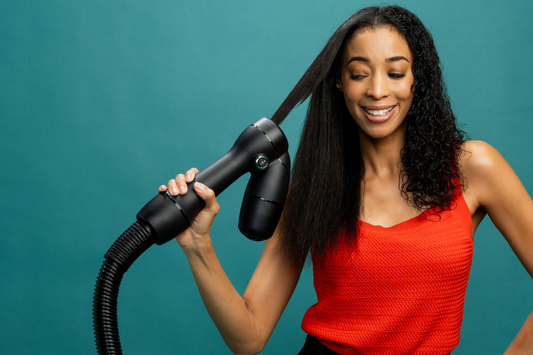
How to Pick the Right Products for Your Hair
As you know by now, understanding your hair type is the first step in maintaining healthy hair. But what comes next?
Whether you’re an experienced natural or someone who’s recently abandoned keratin treatments, hair bleach, perms, or any other damaging agents, you have two primary goals: find products that work for your hair and use them in a way that’s best for your hair.

What Your Hair Needs
Hair products should address two critical needs: moisture and protein. How much moisture and protein your hair needs depends on a few factors.
For one, you must know your hair type and porosity level. One of our recent blog posts was a complete breakdown of hair types. If you missed it, you can read it here. Hair porosity is the other side of the equation.
It simply refers to your hair's ability to absorb and retain moisture. There are three levels on the porosity spectrum: low, normal and high. Understanding your hair’s porosity level will better help you choose the right products, than if you only knew your hair type.
So, the first step is knowing your hair type, then your hair’s porosity level, and finally finding the right products that works best. Seems simple enough right?
Not so much when there’s tens of thousands of products on the market. It can be overwhelming to decide where to start, and you might just give up before you even begin the hunt for new products.
We understand your frustration.
It’s even more frustrating when you spend hours watching Youtube videos in pursuit of an influencer whose hair looks the most like yours.
You think you’ve found the one, so you buy all of the products they used for their wash day routine, excited to get the same exact results.
Only to have the worst hair day of your life!

You ask yourself, “where did I go wrong?” You followed their directions to the T, but did not get the same results.
Trial and Error
This is where we step in to tell you unfortunately it’s not that easy. As a viewer, we don’t see the Youtuber’s trial and error process.
They’ve spent x amount of dollars on x amount of hair products, testing and retesting. They’ve tried products that their hair hated, and products that their hair loved.
What may work for them, may not work for you. Which is why you have to go through your own trial and error process.
The best way to breakdown your hair care routine in order to find products to test is step by step.
Everyone’s wash day routine has a similar structure: shampoo, conditioner, leave-in, and the optional styling product.
Some wash days can get more technical, involving deep conditioning, protein treatments, so on and so forth.
Moisturizing Shampoo vs Clarifying Shampoo
Moisturizing shampoos are recommended for daily/weekly washes. Your best bet is looking for a moisturizing shampoo that does not contain sulfates.
Although sulfates allow dirt and dead skin cells to be removed easily from your skin and hair, they can also strip natural oils from the scalp and hair.
This can make hair dry and brittle. If your scalp is sensitive, sulfates can cause irritation like redness, dryness, and itching.
Shampoos have a tendency to strip hair follicles of its natural moisture. If you do not have too much buildup and wash your hair multiple times a week, shampoo only once.
If you have chemically processed hair, look for a moisturizing shampoo that is made for chemically processed hair. Bleach and dyes are prone to drying out hair, therefore, having a shampoo that adds to the dryness is no where near beneficial.
If you’re transitioning from processed hair to natural hair, shampoos that aid in repairing hair follicles are perfect for you.
A clarifying shampoo is necessary when you experience weeks of dirt buildup. If you’ve gone more than two weeks without washing your hair, a clarifying shampoo should be used because it strips hair of all dirt.
When you use a clarifying shampoo, it’s imperative to rejuvenate your hair follicles throughout the rest of your wash routine to add back the moisture your hair needs.
Conditioners

There are three types of conditioners: rinse-out conditioner, deep conditioner, and leave-in conditioner. All three can be used in tangent with each other or by itself, depending on the wash day.
Rinse-out Conditioner
Rinse-out conditioner is your traditional conditioner that is used after you shampoo your hair. It creates great slip. Slip refers to how lubricious the product makes your hair feel after applying so that you’re able to better detangle your hair.
Often times, we buy a shampoo and conditioner from the same brand within the same line of products. This isn’t always necessary.
You may find a shampoo your hair likes from one brand, but a conditioner from another brand that it also likes because it creates more slip.
It’s recommended to leave your rinse-out conditioner in for 5 minutes. If your hair is curly or coily, it is best to part your hair into sections before detangling.
Deep Conditioner
Deep conditioners are used as an additional product to moisturize and repair hair follicles. They should be applied thoroughly and left in your hair anywhere from 20 minutes to overnight.
The harder it is for your hair to retain moisture, the more often you should deep condition your hair.
If you hair is prone to producing a lot of natural oils, you would not need to deep condition it as frequently.
Deep conditioner is usually recommended to be added to freshly washed hair, but some women prefer to apply it before they wash their hair. This is another place where trial and error is common practice, because you wouldn’t know which method your hair prefers if you do not try both.
Leave-in Conditioner
Leave-in conditioner is an important product for women with Type 3 and 4 hair. Many women with curly and coily hair textures use it as a pre-styling product.
For example, leave-in conditioner can be used as a key product in a wash-and-go, or a protective style such as a two-strand twist.
Some rinse-out conditioners double as a leave-in conditioners, but many women prefer to use different products for each.
Protein Treatments
Protein treatments should only be incorporated into your wash routine on an as-needed basis. Protein is essential when it comes to hair, nails, and skin. It is used to build tissue cells that help keep your hair healthy and growing.
However, because protein naturally occurs in our hair, (we call it keratin in this form), too much protein can cause more harm than good.
Understanding if your hair needs a protein treatment will depend on the state of your hair. If your hair is pretty healthy, you should only consider getting a protein treatment every few months. If you are unsure, the best way to know is to perform a hair strand test.
Protein can be added through hair supplements pills or you can easily incorporate it into your at-home wash day routine.
Products that can help with the lack of protein in your hair are products such as hair masks, deep conditioners, leave-in conditioners, or a shampoo and conditioner combo. You can buy them from the beauty store or create your own DIY mask.
There are tons of DIY recipes on the internet, especially Youtube. The egg hair mask is one of the oldest hair care rituals. To do an egg mask, you simply take one egg, whip it up, and apply it to your hair and scalp.
Let it sit for a half an hour, and then wash it off with a mild shampoo. It is simple and cost-effective because eggs are rich in fat, protein and good for moisturizing the scalp.
Serums
The primary purpose of hair serum is to make your locks look shinier, less tangled and healthier. This happens as the serum absorbs and reflects light.
It makes your hair look glossier, while also adding a protective coat to the hair, thus protecting your hair from dust, pollutants and ultra violet rays.
Which type of serum is right for you?

If your hair is prone to frizz, hair serums are a great styling product to use after you style your hair. There are specific hair serums suited for different kinds of hair.
You can use them to prevent hair breakage, and you can also make hair serums at home that can be highly beneficial for your hair.
If you have split ends, serums that are made with keratin are best because keratin is known to repair aggravating split ends, and prevent strands from splitting.
If you live in a warmer climate, your hair needs extra protection from the sun. Serums made with lavender oil should be your go-to. Not only does lavender oil nourish and add sheen to your hair, it will also help to protect your hair against heat.
If you have curly hair, frizz is harder to manage than other hair types. To keep those curls bouncy, glossy and bring them back to life, use serums packed with hydrating oils like jojoba, argan, sweet almond and marula.
If you have coily hair, you know how hard it can be to keep your coils hydrated. Serums infused with argan and Moroccan oils will give it a healthy shine and lock in moisture.
How to use serums
Serums are best applied on freshly washed hair at the end of your routine. If you apply a serum on a daily basis, it will weigh down your hair and make it look oily. It’s important to understand that serum is not just a styling product.
It provides nourishment to your hair.
Do not use an excessive amount of serum. For medium length hair, use 1-2 drops of serum and for longer hair, use 3-4 drops of serum. Make sure to distribute some to your scalp, but mainly focus on the ends of your hair.
Hair Gel
Hair gels are popular amongst all hair types to create hold and definition, but not all hair gels are made equal. Many women experience flaking after they’ve applied gel to their hair.
Flaking happens when a gel doesn’t combine well with your natural hair and can also be a reaction to your conditioner.
For the best results when using a gel, use on freshly washed and wet hair, or lightly dampen dry hair. Then apply the hair gel and style to your liking.
Gel can be used to enhance your natural curl pattern, or hold your hair in place, like a hairspray might.
They work best with wash-and-go’s and slicked back ponytails or buns.
Be patient and trust the process
Searching for the right products for your hair can be a strenuous and even expensive process. The internet will be your best friend in finding products that are not only compatible with your hair, but within your budget.
Our hair needs as much love and attention as the rest of our body. Try making your own DIY products where you can.
Research alternative methods if something does not work for you. As we mentioned before, it is trial and error.
If your existing hair routine has been failing you as of late, don’t feel discouraged. It is completely normal to change up your hair products and even your routine, especially as the seasons change.
The better you understand your hair, the better results you will get when you use the RevAir Reverse Air Dryer. Our support page has a lot of information to get you started.
If you still have questions, we’ve got you covered. Contact us today and a friendly, knowledgeable member of our team will be happy to speak with you.
It’s important to us that we provide you with the tools and information you need to maintain healthy hair.















